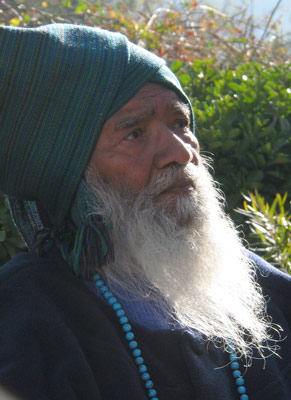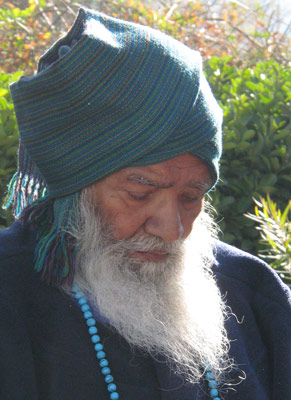This Is The Fourth State

…We are settled in our seats. As soon as we sat for a few minutes, a situation was created that you are not scattered—at least you want to concentrate your mind. You left the field. Now, everyone does not know when they leave the field. The field is this body. And in this body, all the senses are there, the organs are there intact. So it’s a kind of machine, a kind of car. If the mind is not there who’s driving it, then the car cannot move properly on the road; it can go this way, that way. So speech is generally for the purpose of first getting you settled, because you do not know the subject which Mary has just started.
Now you are settled in your being, and you are ready to make an experiment to examine your Self—who is not your nails, or hair, or coat, or shirt, or muffler, or shoes, or chair. You are sitting, and your eyes are closed. That’s why meditation becomes difficult, because each one has to know what he’s going to do when he’s settled and has closed his eyes. So the information is first given by the one who knows the subject. The subject is meditation, and meditation is being performed to unfold that awareness which is not connected to the Self, rather which is connected to the mind and senses, which function properly on the relative field. But when you close your eyes and are not using your hands and feet, or even your tongue to speak, and you are sitting quietly, now, suddenly, a great task came to you: what to do with it?
So let me become each one of you who wants to know what to do at this time. First of all, I am a person sitting in my seat, and I have closed my eyes. I am not sleepy, not dreaming, nor am I a wakeful person who is using his senses. Then, what is this state? It’s other than those three. But this is not known to us. Therefore, we want to get the information first.
This is the fourth state. It is the beginning of the fourth state, which is not known by all human beings. The fourth state is not mentioned anywhere—what its characteristics are, what its quality is, what it is. So I define it, describe it for myself, as if you are describing it for yourself.
I am with closed eyes, and I am alive, and my knower is ready who wants to know something which the eyes are not seeing. When the eyes are not seeing, it is seen—nothing. I conclude that it is nothing. But it cannot be nothing, because I am alive. So nothing means nothing which belongs to the senses. I am alive and my eyes are closed, so things are not seen. But that which remains without things and forms is on. And I am connected to it.
This space and I became one. I—I do not know what I is—and space—I do not know what space is. Now, at this time, you became aware that I is Awareness and this space is Awareness. And in the middle of the whole space all around, all the persons are sitting, a house is sitting, trees are sitting, and this space awareness is all around. But I as a human being am accustomed only to have the knowledge of the senses. But here the senses are not working, not functioning. I have made them settled, not to function. So I am left alone, which means the senses are not having me; they do not know, they do not need me. I am there—but not as a person-body. A name and form are described in the country’s records or somewhere else, it’s alright. But this I is Awareness, Space, Awareness. I have not to give a name for what it is—whether reality or not reality. But I am, and I am aware, and this is what I am as a human being: I am aware that Awareness is not dead, is not sleepy, is not dreamy, is not in the waking state, is not thinking. I am Awareness. This is the fourth state.
In this fourth state, thinking from the waking state will come again and again and intrude it again and again. So, thoughts will come. So I am now with closed eyes and I am thinking. I am waiting for thinking. So I am Pure, I am totally canvas. But out of canvas, I bring in imagination. Without the beginning of imagination, I am Awareness only—but I do not find time for myself to watch that I am Awareness. Why? Thinking keeps coming all the time, or the eyes begin to function all the time, the ears begin to listen to something, and all the actions go on all the time. … [Pause]

But now, it is as if I am waiting for thinking. Many of you must be of the same type that you must be waiting for thinking, or your thinking has come. You know that each one knows thinking or thought. Awareness knows thought. Thought belongs to the mind, so Awareness knows the mind and thought. Mind and thought is one and the same; if thought is not there, it’s not called mind. If you call it mind, then without thinking, it’s not called mind—it is Awareness.
Now, we watch this Awareness: Is there any breakage in this Awareness? Any division? Any birth? Any death? The answer is from the same Awareness—No, I am pure, free, and all the time free and pure, no thing, no form, and no object, no relation. Unless I open the eyes and open the ears and open the other senses, there is only Awareness. To be familiar with this Awareness and sieve it from the mixture of the senses and their functioning, I do meditation.
In meditation, I am now by myself—which means Awareness. Awareness is with Awareness. So there are no two parts—awareness-subject, or awareness-object, or the action in between. Awareness alone is. And we give this Awareness as an information to my mind, which is the mind of everyone, that “My dear mind, this Awareness is Pure Free Forever. You did not know this, and you should know it.” But the mind says, “No. What do I need this for? It is nothing.” The mind only needs some thing, some subject, some concern, some relation, some idea, some imagination, some drawing. So the mind does not accept it.
Then, I do not deal with the mind. I remain Awareness, knowing that I am Awareness. Before that, the mind was making Me as a body with senses, with a name, with my qualifications. But now I am not listening to the mind. I am by myself in meditation.
So that happens through this technique, and we devote some minutes to it. We are satisfied by hearing “some minutes.” There is no time in it, yet we have learned this—minutes and time and days and months and years, so we apply that. But here at this time you are in the timeless state, the formless state, the mindless state, the thoughtless state, the worriless state. You are just Pure Awareness.Copyright © 1999-2008 International
Meditation Institute. All Rights Reserved